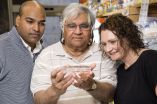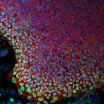(Press-News.org) LA JOLLA--For infants with severe combined immunodeficiency (SCID), something as simple as a common cold or ear infection can be fatal. Born with an incomplete immune system, kids who have SCID--also known as "bubble boy" or "bubble baby" disease--can't fight off even the mildest of germs. They often have to live in sterile, isolated environments to avoid infections and, even then, most patients don't live past a year or two. This happens because stem cells in SCID patients' bone marrow have a genetic mutation that prevents them from developing critical immune cells, called T and Natural Killer (NK) cells.
Now, Salk researchers have found a way to, for the first time, convert cells from x-linked SCID patients to a stem cell-like state, fix the genetic mutation and prompt the corrected cells to successfully generate NK cells in the laboratory.
The success of the new technique suggests the possibility of implanting these tweaked cells back into a patient so they can generate an immune system. Though the new work, published March 12, 2015 in Cell Stem Cell, is preliminary, it could offer a potentially less invasive and more effective approach than current options.
"This work demonstrates a new method that could lead to a more effective and less invasive treatment for this devastating disease," says senior author Inder Verma, Salk professor and American Cancer Society Professor of Molecular Biology. "It also has the potential to lay the foundation to cure other deadly and rare blood disorders."
Previous attempts to treat SCID involved bone marrow transplants or gene therapy, with mixed results. In what began as promising clinical trials in the 1990s, researchers hijacked virus machinery to go in and deliver the needed genes to newly growing cells in the patient's bone marrow. While this gene therapy did cure the disease at first, the artificial addition of genes ended up causing leukemia in a few of the patients. Since then, other gene therapy methods have been developed, but these are generally suited for less mild forms of the disease and require bone marrow transplants, a difficult procedure to perform on critically sick infants.
To achieve the new method, the Salk team secured a sample of bone marrow from a deceased patient in Australia. Using that small sample, the team developed the new method in three steps. First, they reverted the patient cells into induced pluripotent stem cells (iPSCs)--cells that, like embryonic stem cells, have the ability to turn into any type of tissue and hold vast promise for regenerative medicine.
"Once we had patient-derived stem cells, we could remove the genetic mutation, essentially fixing the cells," explains one of the first authors and Salk postdoctoral researcher Amy Firth.
The second innovation was to use new gene editing technology to correct the SCID-related genetic deficiency in these iPSCs. To remove the mutation, the researchers used a technology called TALEN (similar to the better known CRISPR method). This set of enzymes act as molecular scissors on genes, letting researchers snip away at a gene and replace the base pairs that make up DNA with other base pairs.
"Unlike traditional gene therapy methods, we aren't putting a whole new gene into a patient, which can cause unwanted side effects," says Tushar Menon, first author and Salk postdoctoral researcher. "We use TALEN-based genome editing to change just one nucleotide in one gene to correct the deficiency. The technique is literally that precise."
The third step of the work was to prompt the cells to proliferate into the vital immune system cells--not an easy task, but one that could offer a potentially unlimited supply that can be transplanted back into patients at intervals. To do this, the researchers collaborated with scientists at the University of California, Los Angeles, to use a concoction of nutrients and other factors that would encourage the iPSCs to generate NK cells.
And they succeeded. These corrected cells-in-a-dish did indeed develop mature NK cells.
Next, the team is working on reproducing the other vital immune components, T cells. So far, they have prompted the iPSCs to turn into the precursors of T cells, but have not yet been able to coax them to maturity.
"Ultimately, we hope these efforts will help lead to the 'holy grail' in the field: the ability to create stem cells from iPSCs capable of generating all types of blood and immune cells," says Verma, who is also the Irwin and Joan Jacobs Chair in Exemplary Life Science. The ability to generate the corrected blood stem cells themselves could yield a one-time treatment that would ultimately replenish functioning cells throughout a patient's whole life.
"In lieu of that happening, we have an alternative that could work as a less invasive treatment and with the ability to easily scale up to mass quantities," says Firth. Another benefit to using patient-derived cells as treatment is that the patient's body typically won't reject them (unlike donor tissue).
INFORMATION:
Other authors on the paper include: Susan Qualls, William Gilmore, Eugene Ke, Oded Singer, Leif Anderson and Alexander Bornzin from the Salk Institute; Deirdre Scripture-Adams, Zoran Galic and Jerome Zack from UCLA; and Ian Alexander of the Children's Medical Research Institute and The Children's Hospital at Westmead in Australia.
This work was supported in part by grants from Ipsen/Biomeasure, Sanofi Aventis, the H.N. and Frances C. Berger Foundation, the Leona M. and Harry B. Helmsley Charitable Trust and the California Institute for Regenerative Medicine.
About the Salk Institute for Biological Studies:
The Salk Institute for Biological Studies is one of the world's preeminent basic research institutions, where internationally renowned faculty probes fundamental life science questions in a unique, collaborative and creative environment. Focused both on discovery and on mentoring future generations of researchers, Salk scientists make groundbreaking contributions to our understanding of cancer, aging, Alzheimer's, diabetes and infectious diseases by studying neuroscience, genetics, cell and plant biology and related disciplines.
Faculty achievements have been recognized with numerous honors, including Nobel Prizes and memberships in the National Academy of Sciences. Founded in 1960 by polio vaccine pioneer Jonas Salk, MD, the Institute is an independent nonprofit organization and architectural landmark.
In a new study, published in Cell Reports, researchers at Uppsala University describe a novel mechanism by which lymphatic vessels form during embryonic development. The finding may open new possibilities for repairing damaged lymphatic vessels using stem cells.
Olof Rudbeck, professor of medicine at Uppsala University, discovered the lymphatic vascular system in the 17th century. A research group at the institute bearing his name, the Rudbeck Laboratory at Uppsala University, has now discovered a novel origin of the lymphatic system.
The prevailing textbook knowledge ...
In 1953 Watson and Crick first published the discovery of the double helix structure of the DNA. They were able to visualize the DNA structure by means of X-Ray diffraction. Techniques, such as electron microscopy, allowed scientists to identify nucleosomes, the first and most basic level of chromosome organisation. Until now it was known that our DNA is packaged by regular repeating units of those nucleosomes throughout the genome giving rise to chromatin. However, due to the lack of suitable techniques and instruments, the chromatin organisation inside a cell nucleus ...
An extensive database identifying immune traits, such as how immune cell function is regulated at the genetic level in healthy people, is reported by researchers from the National Institutes of Health (NIH) and their collaborators in the journal Cell. While many genetic risk factors have been linked to various diseases, including autoimmune disorders, how a genetic change causes susceptibility to a disease is not always clear. By studying healthy people, researchers from the National Institute of Allergy and Infectious Diseases (NIAID) Vaccine Research Center, part of the ...
Ponds in the Arctic tundra are shrinking and slowly disappearing, according to a new study by University of Texas at El Paso (UTEP) researchers.
More than 2,800 Arctic tundra ponds in the northern region of Alaska's Barrow Peninsula were analyzed using historical photos and satellite images taken between 1948 and 2010. Over the 62-year period, the researchers found that the number of ponds in the region had decreased by about 17 percent, while pond size had shrunk by an average of one-third.
"The 17 percent is a very conservative estimate because we didn't consider ...
Being discriminated against by the healthcare profession or system can cause much more than just mere distress to older people. Such experiences can literally be bad for their health. A national survey shows that one in every three older Americans who are on the receiving end of age-related discrimination in the healthcare setting will likely develop new or worsened functional ailments in due course. This follows a study1 led by Stephanie Rogers, a fellow in geriatrics at UC San Francisco in the United States, and published in the Journal of General Internal Medicine2, ...
NEW YORK, NY -Where you receive medical care impacts many things - including whether or not you receive inappropriate medical tests, according to a new study.
Researchers from NYU Langone Medical Center and its Laura and Isaac Perlmutter Cancer Center, in a new retrospective study publishing online March 12th in JAMA Oncology, conclude that patients with low-risk prostate or breast cancer were more likely to receive inappropriate imaging during treatment, based on the region of the country in which they received medical care.
They examined medical records from 2004-2007 ...
An association of high rates of inappropriate imaging for prostate cancer and breast cancer identified in a study of Medicare beneficiaries suggests that, at the regional level, regional culture and infrastructure could contribute to inappropriate imaging, something policymakers should want to consider as they seek to improve the quality of care and reduce health care spending, according to a study published online by JAMA Oncology.
Researchers have estimated that 30 percent of resources spent on health care in the United States does not improve the health of patients. ...
In a group of patients diagnosed with colorectal cancer at 40 or younger, 1.3 percent of the patients carried germline TP53 gene mutations, although none of the patients met the clinical criteria for an inherited cancer syndrome associated with higher lifetime risks of multiple cancers, according to a study published online by JAMA Oncology.
Li-Fraumeni syndrome is an inherited cancer syndrome usually characterized by germline TP53 mutations in which patients can develop early-onset cancers and have an increased risk for a wide array of other cancers including colorectal. ...
Cochlear implantation was associated with improved speech perception and cognitive function in adults 65 years or older with profound hearing loss, according to a report published online by JAMA Otolaryngology-Head & Neck Surgery.
Hearing impairment is associated with cognitive decline. In cases of severe to profound hearing loss where there is no benefit from conventional amplification (i.e. hearing aids), cochlear implantation that uses direct electrical stimulation of the auditory nerve has proven successful and selected older patients are among those who can benefit, ...
WASHINGTON - Increasing the minimum age of legal access (MLA) to tobacco products will prevent or delay initiation of tobacco use by adolescents and young adults, particularly those ages 15 to 17, and improve the health of Americans across the lifespan, says a new report from the Institute of Medicine. The committee that conducted the study estimated the likely reduction in tobacco-use initiation that would be achieved by raising the MLA for tobacco products to either 19 years old, 21 years old, or 25 years, and used two tobacco-use simulation models to quantify the accompanying ...



